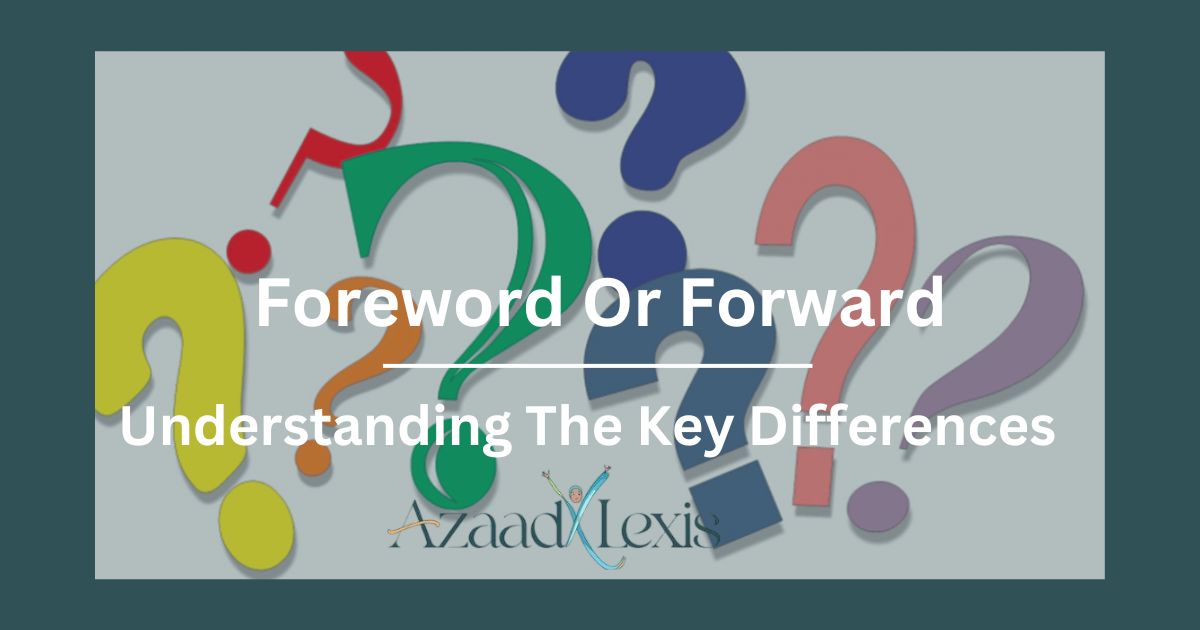The English language is full of words that sound similar but carry vastly different meanings. Among these, foreword and forward often confuse even seasoned writers and speakers.
These words may share pronunciation, but their applications differ in significant ways. This article will provide a detailed guide to help you master their usage, ensuring your writing remains clear and professional.
Understanding Foreword and Forward
Before diving into specific definitions, it’s essential to grasp the broader context of these terms. Both foreword and forward can appear in various contexts, but their meanings and functions are not interchangeable. Understanding these distinctions is crucial for effective communication.
Foreword: Definition and Usage
A foreword is a short introductory section at the beginning of a book, typically written by someone other than the author. Its purpose is to provide context, introduce the author, or offer praise for the work. A foreword sets the stage for the reader, preparing them for what lies ahead in the main content.
For example, imagine you’re reading a biography. The foreword might be written by a close friend of the author, providing personal insights into the author’s motivations and unique storytelling style. It gives readers an insider perspective before delving into the book.
Key points about forewords:
- They are always located at the start of a book.
- They are optional but often add value by offering context or credibility.
- They are written by someone other than the primary author.
Forward: Definition and Usage
The word forward, in contrast, has nothing to do with books or introductions. It is an adverb, adjective, verb, or noun, depending on its usage. Common meanings include moving ahead, sending onward, or progressing.
For example:
- As an adverb: “She walked forward into the room, confident and poised.”
- As a verb: “Please forward this email to the team.”
- As an adjective: “His forward-thinking approach revolutionized the industry.”
The versatility of forward allows it to fit seamlessly into many sentences, but it never serves as an introductory note in a book. This distinction is critical.
Read this Blog: Ways to Say “Dream Come True” Professionally
Side-by-Side Comparison
To clarify the differences further, let’s compare foreword and forward directly:
| Aspect | Foreword | Forward |
| Meaning | Introductory section in a book | Moving ahead, sending onward, or progressing |
| Part of Speech | Noun | Adverb, adjective, verb, or noun |
| Usage Context | Books, especially in formal writing | Everyday language, directions, communication |
| Example Sentence | “The foreword was written by a historian.” | “Please forward the package to my new address.” |
By understanding these contrasts, you can avoid common mistakes and ensure your language choices are precise and appropriate.
Everyday Usage Examples
To help solidify the differences, here are some scenarios where foreword and forward might appear:
- Foreword Example:
- You’re reading a novel, and the foreword is written by a literary critic who shares insights about the author’s writing style and background.
- Forward Examples:
- Direction: “Take two steps forward and turn left.”
- Communication: “I’ll forward this message to the manager.”
- Progress: “Her forward-thinking ideas are transforming the company.”
These examples highlight how these words operate in different spheres of language.
FAQs
Can a book have both a foreword and a preface?
A: Yes, a book can have both. A foreword is usually written by someone other than the author, while a preface is written by the author to explain their motivation or process.
Is a foreword always necessary in a book?
A: No, a foreword is optional but can add value by providing context or endorsing the content.
Can “forward” ever be used in the context of books?
A: No, “forward” is not used as an introductory section in books. Its meanings pertain to movement, progression, or communication.
Conclusion
Mastering the difference between foreword and forward is a valuable skill for clear communication. While they sound alike, their functions and meanings are distinct. A foreword introduces a book, offering context or praise, whereas forward relates to movement, progression, or sending something onward. By keeping these distinctions in mind and applying them correctly, you can enhance your writing and avoid common pitfalls.
Remember, foreword is for books, and forward is for everything else. With this knowledge, you can confidently navigate these often-confused words in your writing and conversations.

